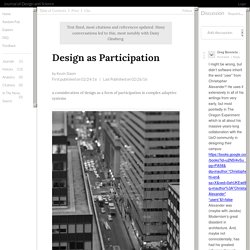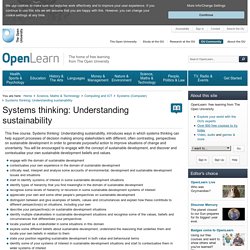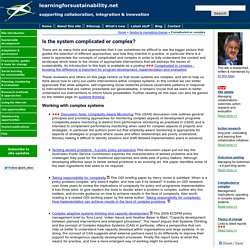

Complexityprimer.eng.cam.ac. How to Cultivate Conditions for Institutional Change. "Living Systems and Leadership: Cultivating Conditions for Institutional Change," by Center senior editor Michael K.

Stone and executive director Zenobia Barlow, explores the application of Living Systems Theory to institutional and societal change. It draws examples from the Center's work in food systems, especially our work on multiple levels of scale in the Oakland (California) Unified School District. The article appeared originally in a slightly different form as a scholarly feature in the Journal of Sustainability Education's March, 2011 edition, whose theme is "Learning and Leading Sustainability. " Download the article (737k pdf) The Journal of Sustainability Education is a peer-reviewed forum to share, critique, and promote research, practices, and initiatives around sustainability. Ssm. Sts2012c lynam presentation. The Actor Network Resource, Lancaster University. Science Studies Centre, Department of Sociology, Lancaster University, UK ANT Resource (Home Page) CSS Home Page | ANT Resource Thematic List | ANT Resource Alphabetical List Introduction 'Actor-network theory': What is it?

Living With Complexity. Systemic Design Research Network. Open University Guide to Diagrams. A Systems Story (Systems Thinking) Linda Booth Sweeney > Learning About Systems. Learning about systems isn’t always easy.

We can’t actually see most systems. Instead, we have to imagine the interconnections and processes that give a system integrity. The English language, with its emphasis on nouns and objects over verbs and processes, can limit our awareness of the living systems in our daily lives. Our everyday artifacts – newspapers, magazines, books, and textbooks — even the signage in some museums and nature centers – often direct our attention to isolated events and fragmented information, rather than to interrelationships, patterns, and trends.
In school, many of us were taught subjects in a compartmentalized way, with history in one class, natural science in another, social studies in yet another, and so on. Design as Participation. You’re Not Stuck In Traffic You Are Traffic This started with a drivetime conversation about contemporary design with Joi Ito.

We were stuck in traffic, and in our conversation, a question emerged about designers: The answer is another question, a hypothesis. The hypothesis is that most designers that are deliberately working with complex adaptive systems cannot help but be humbled by them. Stakeholder Relations and Systems Change: the New Challenge for Business Leaders? — Change The Conversation.
Toward Sustainable Design Thinking - thedesigngym.comthedesigngym.com. Introducing environmental decision making - OpenLearn - Open University - T863_1. We all make decisions in everyday life, both as individuals and in groups.

These range from simple – for example, choosing what to eat, which route to take to work, which products to buy in the shop – to complex decisions about changing jobs, moving house, choosing schools and participating as a member of a local community in planning decisions and improvements. Nature matters: systems thinking and experts: Learning outcomes - OpenLearn - Open University - TD866_3. Systems thinking: Understanding sustainability - OpenLearn - Open University - T306_3. In our increasingly complex world of change and uncertainty, particularly in the context of climate change, the notion of sustainability is often raised as the key issue for decision making in the 21st century.

But sustainability is itself a contentious term and often used in misguided ways depending on the context of use. This unit introduces ways in which systems thinking can help support processes of decision making amongst stakeholders with different, often contrasting, perspectives on sustainable development in order to generate purposeful action to improve situations of change and uncertainty. Managing complexity: a systems approach – introduction - OpenLearn - Open University - T306_2. Introducing systems thinking. Copyrighted image Copyright: OU Ever heard the expression: 'The whole is greater than the sum of the parts'?

Systems thinking enables you to grasp and manage situations of complexity and uncertainty in which there are no simple answers. It's a way of 'learning your way towards effective action' by looking at connected wholes rather than separate parts. It's sometimes called practical holism. Managing complexity: a systems approach – introduction - OpenLearn - Open University - T306_2. Systems diagramming - OpenLearn - Open University - T552_1. Systems thinking and practice - OpenLearn - Open University - T551_1. What is a system? What is systems thinking? Systems thinking. Systems one: An introduction to systems thinking.
Systerns One: cln In!

Roduc/ion /o Sys! Erns Thinking by Future Sybterns, Inc. All rights reserved. Managing complex adaptive systems. There are so many tools and approaches that it can sometimes be difficult to see the bigger picture that guides the selection of different approaches, and how they interlink in practice.

In particular there is a need to appreciate the concepts of complicated and complex in order to fully understand the context and landscape which leads to the choice of appropriate interventions that will address the issues of sustainability. An introduction to this topic is available as a posting Complicated or complex - knowing the difference is important for program development, implementation and evaluation. Linda Booth Sweeney > Thinking About Systems > 12 Living System Principles. There are living systems on all scales, from the smallest plankton to the human body to the planet as a whole.

When we understand what constitutes a living system, we see that a family, a business, even a country are also living systems. Overview. Systems thinking is not the same as holistic thinking. Let’s deconstruct this often made claim that systems thinking (ST) stands in contrast to (in this case on opposite ends of a continuum from) reductionism. This claim appears reasonable at first, and it is one made my many of the founding fathers of systems thinking as well as contemporary systems thinkers. But there are some dangers, mostly having to do with misleading people new to the field toward misunderstanding what it means to be a systems thinker. First, if reductionism (breaking things down into their constituent parts) is on one side of a continuum, then holism (seeing things in the context of their whole) is on the other. If reductionism is the opposite of ST, then ST and holism are synonymous.
Here lies the problem… No matter how holistic one gets, there is always a larger whole to act as context, and one is therefore always surgically removing the whole under consideration from the whole it is a part of, which is one of the chief criticisms with reductionism. Amazon. Systems Thinking: Critical Thinking Skills for the 1990s and Beyond. SystemsThinker.pdf. The promise – and problem – of systems thinking. As a former biology teacher, I understand that life is an “interconnected web.” Why, I taught my students about the food chain and the water cycle and the exchange of oxygen and carbon dioxide. Of course, I understood even at the time that these were simplistic and incomplete models. What I didn’t recognize was that I was trying to teach complexity with the wrong tool. The primary tool we use as educators is analysis (read more in my previous post “Is our educational system teaching us to objectify the world“). But, like a beam of light in a darkened room, analysis can only reveal a few isolated elements at a time, while failing to show us the big picture.
The need to understand the big picture of systems dynamics is great. Effective solutions can only be found by understanding and responding to the dynamics of the system. Feature Article: Learning the Lessons of Systems Thinking: Exploring the Gap between Thinking and Leadership - Integral Leadership Review. It is worth describing the postmodern chain of discourse that followed the blo’s publication. Consider that this piece started as my informal response on the Transforming Transformation email discussion list, in response to a blog post that was circulated as a link on that list. Several of the regulars on the list responded to Fred’s piece at the Fast Company blog. I was invited to formalize the post as a kind of scholarly letter. Twitter was involved at several points, as well. (Twitter posts have led to other articles). Dr.